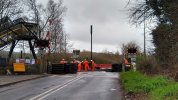ivorytoast28
Member
Today I was on the 13:25 Woking to Portsmouth harbour service and as we approached Milford we slowed down and stopped in the station (despite not being scheduled to call there)
I was in the front carriage and could see that cars were crossing the tracks in front of us. After about a minute the lights of the crossing came on and the barriers went down and we proceeded through. I can only think that due to the engineering works and amended timetable we were using the path of a service that usually stopped at Milford. But it felt very weird having the train stop for cars rather than the other way around
I was in the front carriage and could see that cars were crossing the tracks in front of us. After about a minute the lights of the crossing came on and the barriers went down and we proceeded through. I can only think that due to the engineering works and amended timetable we were using the path of a service that usually stopped at Milford. But it felt very weird having the train stop for cars rather than the other way around

